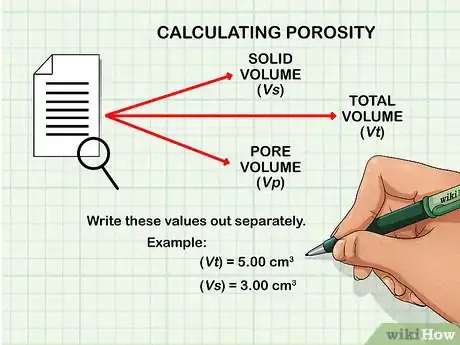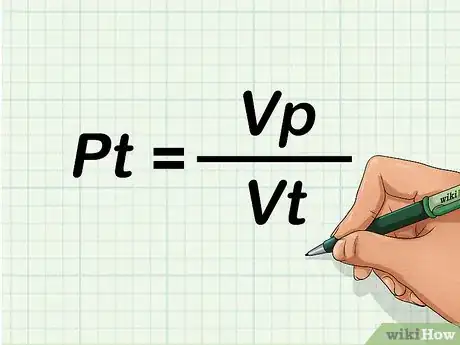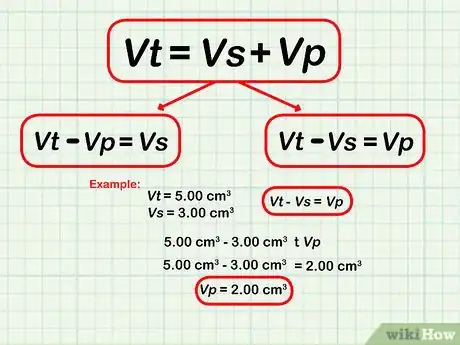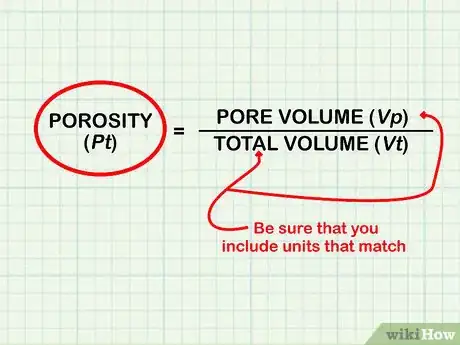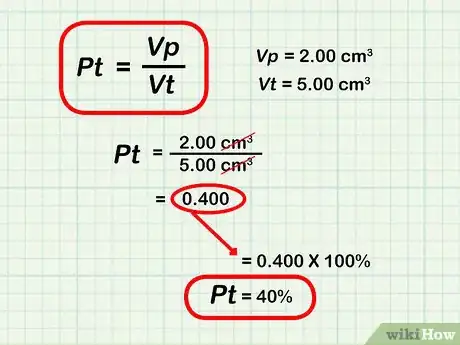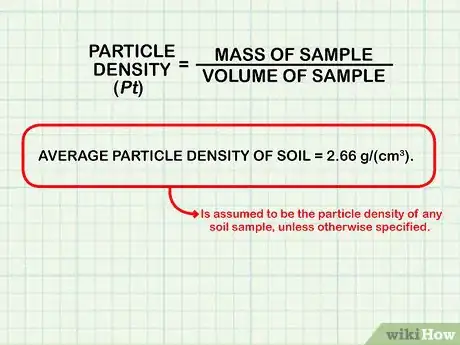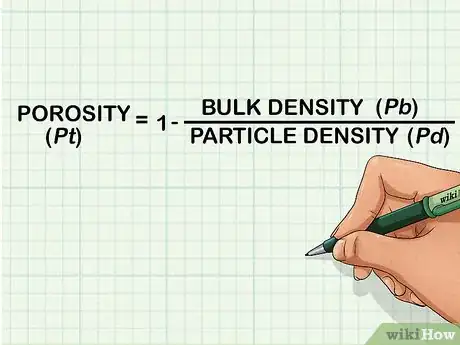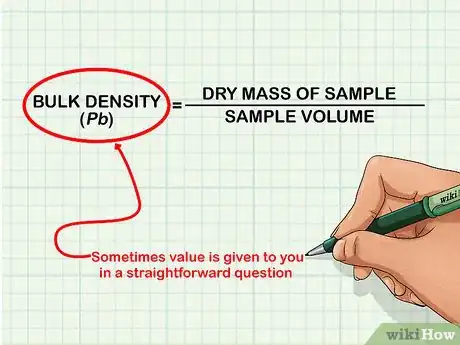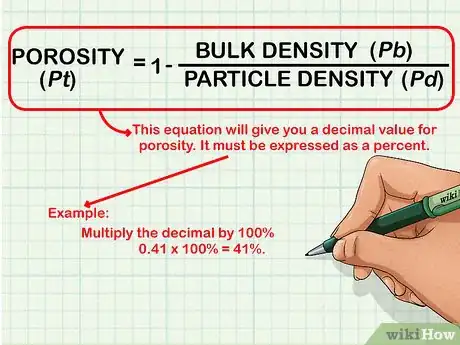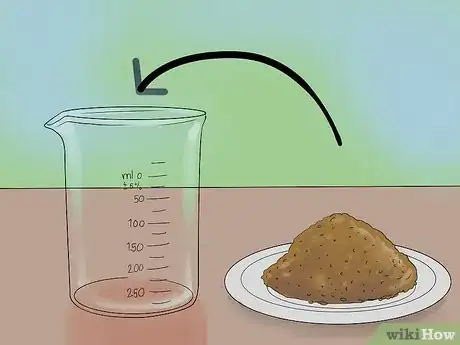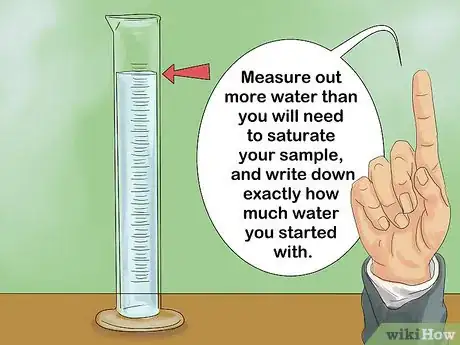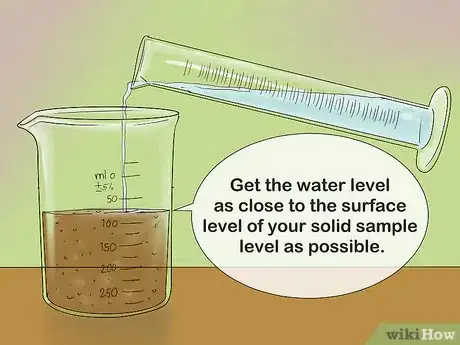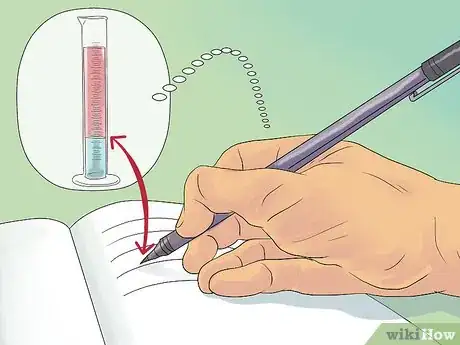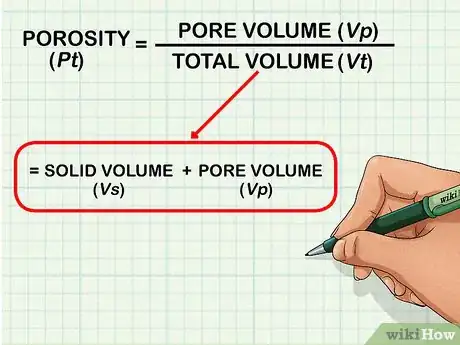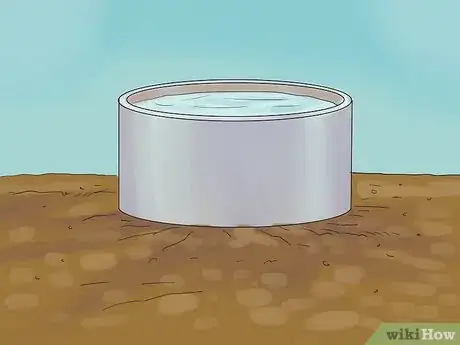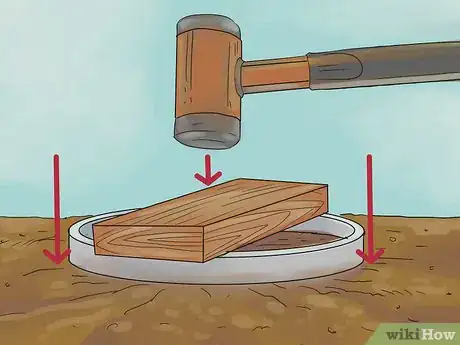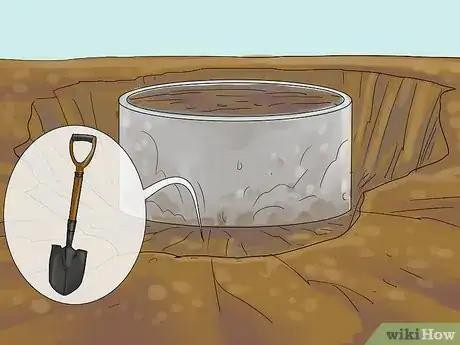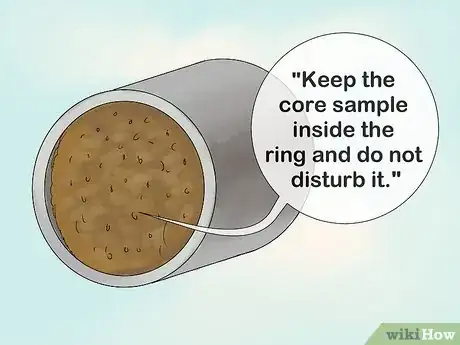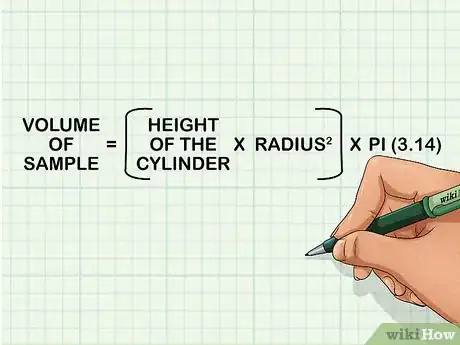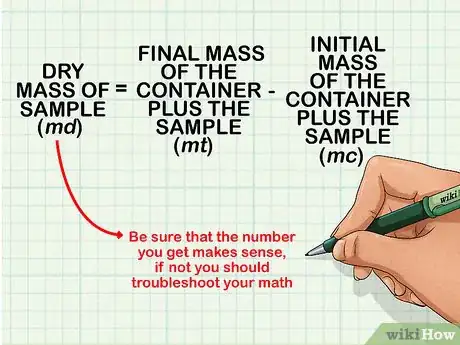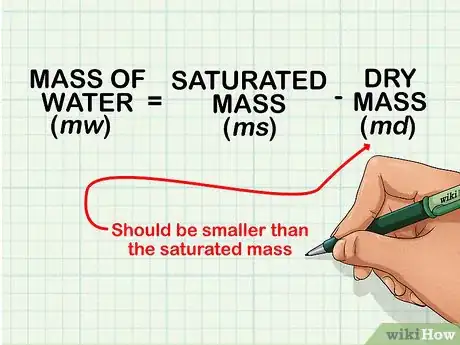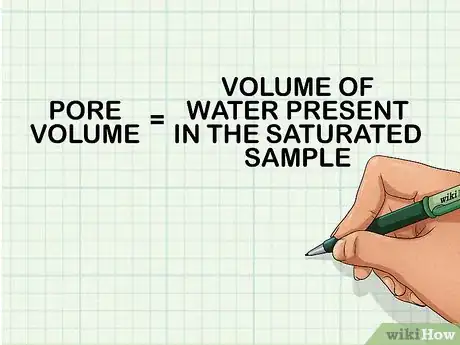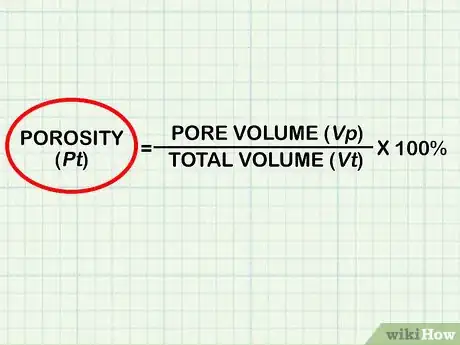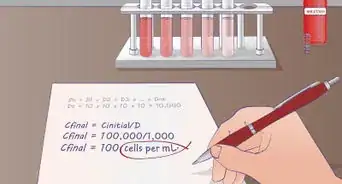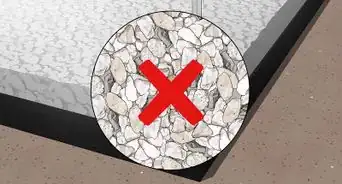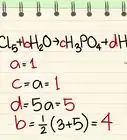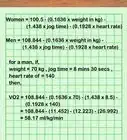This article was co-authored by Bess Ruff, MA. Bess Ruff is a Geography PhD student at Florida State University. She received her MA in Environmental Science and Management from the University of California, Santa Barbara in 2016. She has conducted survey work for marine spatial planning projects in the Caribbean and provided research support as a graduate fellow for the Sustainable Fisheries Group.
This article has been viewed 250,970 times.
Porosity is the value used to describe how much empty, or void, space is present in a given sample. This attribute is commonly measured in regards to soil, since appropriate porosity levels are necessary for plants to grow. Porosity can be calculated theoretically using equations and given values, which is the case when you are faced with exam questions. Porosity can also be determined by finding the values needed to solve the equations experimentally, either in the lab or in the field.
Steps
Calculating Porosity Theoretically by Volumes
-
1Extract useful values from the given information. When calculating porosity theoretically, you will be given an example situation that contains some of the values you need. Read your question carefully and look for values such as total volume (), solid volume (), and pore volume (). Always pay close attention to the units of these values.
- It will help to write these values out separately. For example, if your question provides and , you would write:
- = 5.00 cm^3
- = 3.00 cm^3
- It will help to write these values out separately. For example, if your question provides and , you would write:
-
2Set up the appropriate equation. By definition, porosity () is equal to the pore volume () divided by the total volume (), or = /. Keep in mind that this is not the only equation that can find porosity. If values are given for bulk density and particle density rather than values for volumes, you should use a different equation.[1]Advertisement
-
3Find values for your volume variables. It is helpful to keep in mind that is the sum of solid and pore volumes, or = + . This relationship can be rearranged to allow you to solve for the any of the volume variables, as long as the other two are known. For example, and - = .[2]
- Using the same values as listed in previous steps, = 5.00 cm^3 and = 3.00 cm^3, we can solve - = to find that = 5.00 cm^3 - 3.00 cm^3 = 2.00 cm^3.
-
4Plug your known volume variables into the porosity equation. Once you have determined a value for and a value for , you can plug them into the porosity equation, = /. Be sure that you include units for and . Also, you should be sure that the units match, if not, you will need to do dimensional analysis to make them match.
- It’s important to match the units because porosity is a unitless value that is usually expressed as a percentage. The units from the volume variables will cancel each other out by division.[3]
-
5Solve the equation to obtain a porosity value. Now that your equation is totally set up and has the appropriate values in place, you can solve by doing simple arithmetic. It might help to have a calculator handy for this part.
- Since porosity is often expressed as a percent, once you have found the decimal value, it is common to multiply this value by 100%.
- Using the same values from the above examples, your equation will look similar to this:
- = 2.00 cm^3 / 5.00 cm^3 = 0.400.
- If you would like to express that value as a percent, you would multiply it by 100% to yield = 40%.
Calculating Porosity Theoretically by Densities
-
1Assume the particle density () of your sample to be 2.66 g/(cm^3). The particle density of a sample is equal to the mass of the sample divided by volume of the sample. When dealing with soil samples, the average particle density of soil is 2.66 g/(cm^3). For that reason, this value is assumed to be the particle density of any soil sample, unless otherwise specified.[4]
-
2Use the relationship between volume and density to derive your equation. Since density is defined as mass per volume, and porosity is a comparison of pore volume to total volume, it is possible to express porosity in terms of density as well. The result is the equation = (1 - /) where is your porosity, is the bulk density, and is the sample’s particle density.[5]
-
3Find your value. The value will be given to you in a straightforward question. If the value is not given, you may be given other values such as the dry mass of the sample and the sample’s volume. In this case you would divide the dry mass of the sample by the sample volume to find your bulk density, or .
-
4Solve the equation by inserting the appropriate density values. Now that you have obtained values for and , you can solve for . Note that the value obtained by dividing by should ALWAYS be less than 1, thus the equation = (1 - /) should never yield a negative answer. If it does, you likely divided by , which is incorrect.[6]
- This equation will give you a decimal value for porosity. To express porosity as a percent, simply multiply that decimal by 100%. For example, 0.41 x 100% = 41%.
Calculating Porosity Experimentally by Saturation
-
1Measure the volume of your sample. You can measure the volume directly if your sample exactly fills a container with a known volume. You can also transfer the sample to a container such as a pre-measured beaker to measure volume. If you are unable to measure the volume directly, you can calculate the volume mathematically.
- Note that transferring the sample from one container to another may affect the porosity by disrupting the material.
-
2Measure a volume of water. It is not important exactly how much water you measure out. The two things that are important in this step are measuring out more water than you will need to saturate your sample, and writing down exactly how much water you started with. This is the only way you can know how much you used.
-
3Saturate the sample with water. This is an easy step, but can tricky. You want to add enough water so that all of the pores in your sample are filled, but you do not want to add any extra water. While it is important to get as close as you can to exactly saturating the sample, there will be some degree of error. Get the water level as close to the surface level of your solid sample level as possible.[7]
-
4Record the volume of water used. To do this, you will need to subtract the volume of water that is left from the volume of water you started with. This will leave you with the volume of water that was poured out. The volume of water you used is (approximately) equal to the pore volume of your sample.[8]
-
5Set up the equation to solve for porosity with volume. Now that you have the volume of your sample () and the pore volume (), you can add them together to get total volume (). It is now possible to use the equation = (/) x 100% to find your porosity (). [9]
-
6Do the calculations to find your sample’s porosity. Enter the appropriate values into the equation. Be sure to keep track of your units and make sure that they cancel out appropriately, as porosity is a unitless value. A calculator might be handy for this step, also.[10]
Calculating Porosity in the Field by Taking Core Samples
-
1Saturate the area you want to sample. A good way to do this is to place a pre-weighed steel ring (such as one with a diameter of 7 centimetres (2.8 in) and a height of 10 centimetres (3.9 in)) on the ground where you would like to take a sample and fill it with water. Allow the water to sit in the ring overnight, or until it is absorbed by the ground. This will make it easier to collect your sample.[11]
- You can find pre-weighed steel rings in home improvement stores and online.
-
2Drive the steel ring into the ground. Use a block of wood and a hammer to drive the ring down into the ground. The soil inside the ring is referred to as a core or core sample. The ring protects the core sample from being disturbed during collection.
-
3Dig out around the steel ring. Use a spade and other digging tools to carefully dig around the steel ring. You do not want to disturb the soil inside the ring. Cut away any roots from the bottom of the ring.
-
4Remove the ring. Once you have cleared out the soil around the ring, you can remove the ring and sample from the hole. Keep the core sample inside the ring and do not disturb it. Be careful not to lose any of the sample when moving it.
-
5Record the saturated mass of your sample. Put the ring in a large, clear container. Add water until the sample in the ring is fully saturated and can hold no more water. Weigh the sample in the steel ring. Subtract from that value the mass of the steel ring. This will leave you with the saturated mass of your sample.
-
6Record the volume of your sample. The volume of your sample will be the same as the volume of your ring. Since your ring is a cylinder, to calculate the volume you will multiply the height of the cylinder by the radius squared (the radius is the distance from the center of the circle to the edge), and then multiply that by pi (often rounded to 3.14). If you do not know the radius you can measure across the top of the cylinder at its widest point and divide that measurement by two.[12]
-
7Transfer the soil to an oven safe container. Be sure to pre-weigh the container and write down the mass of the container (). If you are planning to use a microwave oven to dry your sample, be sure that your container has no metal and is microwave safe.
-
8Dry your sample. If you are using a microwave, 10 minutes on high should be sufficient to dry out your sample. This ensures that all of the pores in the sample have been cleared of water. You can also dry the sample in a conventional oven at a temperature of 105 degrees Celsius, or 221 degrees Fahrenheit, for at least 2 hours.Though they are still full of air, this will not affect the mass of the sample.
-
9Weigh your dried sample in the dish to find your total mass (). Remember that this value is not the mass of your sample. It is the mass of your sample plus the mass of your container. Do not use this value to calculate porosity.[13]
-
10Subtract from to find the dry mass of your sample (). To find the dry weight of your sample, you can simply subtract the initial mass of the container from the final mass of the container plus the sample. Be sure that the number you get makes sense. For example, you will not have a negative value for mass. If you do, this is incorrect and you should troubleshoot your math.
-
11Calculate the mass of water in the saturated sample. Subtract the dry mass () from the saturated mass (). The difference will be the mass of water (). Again, the dry mass should be smaller than the saturated mass.
-
12Convert the mass of water to the pore volume of your sample. By definition, one gram of water is equal to one cubic centimeter of water. This means that the mass of your water in grams is equal to the volume of water in cubic centimeters. Since your sample was saturated, all pores are filled with water, therefore, the pore volume is equal to the volume of water present in the saturated sample.
-
13Divide the pore volume by the total volume of your sample. This will yield a decimal number that is smaller than one. Multiply that number by 100%. The result is the porosity of your sample expressed as a percent.
Community Q&A
-
QuestionWhat is the porosity of a 490 cubic centimeter soil sample that contains 85 grams of water when 55% of the pores are full of water?
 Community AnswerThe first step would be to determine how many grams of water would fill 100% of the pores. Since you know that 85 grams fills 55% of the pores, you can divide 85 grams by 55% (or .55) to find that you need 154.5 grams of water to fill all pores. Since one gram of water is equal to one cubic centimeter of water, your pore volume will be 154.5 cubic centimeters. Divide that by your total volume of 490 cubic centimeters and you will get a porosity of .315, or 31.5%.
Community AnswerThe first step would be to determine how many grams of water would fill 100% of the pores. Since you know that 85 grams fills 55% of the pores, you can divide 85 grams by 55% (or .55) to find that you need 154.5 grams of water to fill all pores. Since one gram of water is equal to one cubic centimeter of water, your pore volume will be 154.5 cubic centimeters. Divide that by your total volume of 490 cubic centimeters and you will get a porosity of .315, or 31.5%. -
QuestionWhy is the water absorption of a material such as concrete often determined for periods of immersions of both 10 minutes and 24 hours?
 Community AnswerConcrete tends to absorb less/more water depending on how long it is immersed.
Community AnswerConcrete tends to absorb less/more water depending on how long it is immersed.
Warnings
- The instruments used to take measurements will also affect the degree of error in the measurement. The finer tuned an instrument is, the less error. However, keep in mind that all instruments have their limits.⧼thumbs_response⧽
- Human error is present in all experimental measurements to some degree.⧼thumbs_response⧽
- Disrupting the sample can cause a change in the porosity of the sample by compacting or separating particles. Handle with care.⧼thumbs_response⧽
Things You’ll Need
-
Calculating Porosity Theoretically by Volumes
- Calculator
-
Calculating Porosity Experimentally by Saturation
- Sample
- Sample Container
- Water
- Water Container
-
Calculating Porosity in the Field by taking Core Samples
- Steel Ring
- Hammer and Block
- Spade
- Scale
- Oven or Microwave
References
- ↑ https://www.drillingformulas.com/what-is-porosity/
- ↑ https://www.drillingformulas.com/what-is-porosity/
- ↑ https://www.drillingformulas.com/what-is-porosity/
- ↑ http://passel.unl.edu/pages/informationmodule.php?idinformationmodule=1130447039&topicorder=5&maxto=10&minto=1
- ↑ https://www.youtube.com/watch?v=bMZGn2eQ_70
- ↑ https://www.youtube.com/watch?v=bMZGn2eQ_70
- ↑ https://www.youtube.com/watch?v=SmOz5c95L68
- ↑ https://www.youtube.com/watch?v=SmOz5c95L68
- ↑ https://www.scribd.com/document/371092442/How-to-Calculate-Porosity
About This Article
If you want to calculate porosity theoretically in a given problem, use the equation porosity = pore volume ÷ total volume. Before inserting your values, make sure the units of measurement match because porosity is expressed as a percentage. If you can determine the density of the material, you can also find porosity by using the equation porosity = 1 - bulk density ÷ by particle density. To learn how to calculate porosity through saturation, read on.
